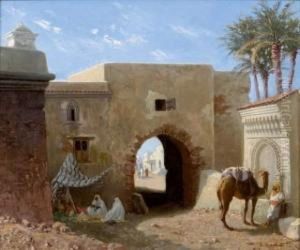Charles Georges Nanteuil Paintings
Charles Georges Nanteuil, born in 1813 and deceased in 1873, was a distinguished French lithographer and engraver, whose work significantly contributed to the art of portrait lithography in the 19th century. Nanteuil’s mastery in capturing the essence and character of his subjects made him a favored portraitist among the literati, politicians, and royalty of his time. His ability to blend technical precision with expressive detail set his work apart, securing his reputation as one of the era's preeminent lithographers.
Nanteuil studied art under influential figures of his time, which honed his skills and developed his unique style. His professional career took off in the 1830s when he began to receive commissions from notable figures in French society. Nanteuil’s technique involved a meticulous approach to lithography, a method that allows for the creation of prints by drawing on limestone with oil-based ink, then using that stone to press images onto paper. This technique was relatively new at the time and offered a range of expressive possibilities that Nanteuil exploited with great skill.
He was not only celebrated for his portraits but also for his contributions to the development of lithography as an art form. Nanteuil's works were highly sought after, and he produced portraits of many significant figures of his time, including Louis Philippe I, Napoleon III, and many writers, artists, and scholars. His ability to capture not just the physical likeness but also the personality and aura of his subjects was unparalleled.
Beyond his artistic achievements, Nanteuil's legacy includes his influence on the generations of lithographers and engravers that followed. He was known for his dedication to his craft and his willingness to experiment with new techniques and approaches. His work remains a significant part of French art history and continues to be studied and admired for its depth, technical skill, and emotional resonance.
Charles Georges Nanteuil passed away in 1873, leaving behind a body of work that continues to be celebrated for its contribution to the art of lithography and portraiture. His portraits not only serve as historical documents but also as testaments to his skill in capturing the human spirit through the medium of printmaking.
